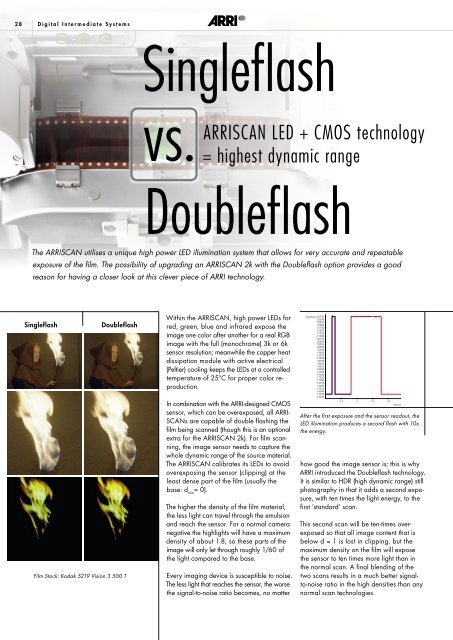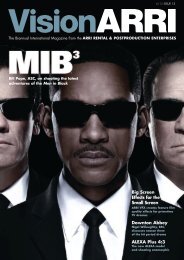ARRI News September 2009 - ARRI Media
ARRI News September 2009 - ARRI Media
ARRI News September 2009 - ARRI Media
Create successful ePaper yourself
Turn your PDF publications into a flip-book with our unique Google optimized e-Paper software.
28 Digital Intermediate Systems<br />
Singleflash<br />
vs.<br />
<strong>ARRI</strong>SCAN LED + CMoS technology<br />
= highest dynamic range<br />
Doubleflash<br />
The <strong>ARRI</strong>SCAN utilises a unique high power LED illumination system that allows for very accurate and repeatable<br />
exposure of the film. The possibility of upgrading an <strong>ARRI</strong>SCAN 2k with the Doubleflash option provides a good<br />
reason for having a closer look at this clever piece of <strong>ARRI</strong> technology.<br />
Singleflash<br />
Doubleflash<br />
Film Stock: Kodak 5219 Vision 3 500 T<br />
Within the <strong>ARRI</strong>SCAN, high power LEDs for<br />
red, green, blue and infrared expose the<br />
image one color after another for a real RGB<br />
image with the full (monochrome) 3k or 6k<br />
sensor resolution; meanwhile the copper heat<br />
dissipation module with active electrical<br />
(Peltier) cooling keeps the LEDs at a controlled<br />
temperature of 25°C for proper color reproduction.<br />
In combination with the <strong>ARRI</strong>-designed CMOS<br />
sensor, which can be overexposed, all <strong>ARRI</strong>-<br />
SCANs are capable of double flashing the<br />
film being scanned (though this is an optional<br />
extra for the <strong>ARRI</strong>SCAN 2k). For film scanning,<br />
the image sensor needs to capture the<br />
whole dynamic range of the source material.<br />
The <strong>ARRI</strong>SCAN calibrates its LEDs to avoid<br />
overexposing the sensor (clipping) at the<br />
least dense part of the film (usually the<br />
base: d min = 0).<br />
The higher the density of the film material,<br />
the less light can travel through the emulsion<br />
and reach the sensor. For a normal camera<br />
negative the highlights will have a maximum<br />
density of about 1.8, so these parts of the<br />
image will only let through roughly 1/60 of<br />
the light compared to the base.<br />
Every imaging device is susceptible to noise.<br />
The less light that reaches the sensor, the worse<br />
the signal-to-noise ratio becomes, no matter<br />
brightness 22750<br />
22500<br />
22250<br />
22000<br />
21750<br />
21500<br />
21250<br />
21000<br />
20750<br />
20500<br />
20250<br />
20000<br />
19750<br />
19500<br />
19250<br />
19000<br />
18750<br />
18500<br />
18250<br />
18000<br />
17750<br />
17500<br />
17250<br />
17000<br />
16750<br />
16500<br />
16250<br />
16000<br />
15750<br />
15500<br />
2.5 5 7.5 10<br />
time (ms)<br />
After the first exposure and the sensor readout, the<br />
LED illumination produces a second flash with 10x<br />
the energy.<br />
how good the image sensor is; this is why<br />
<strong>ARRI</strong> introduced the Doubleflash technology.<br />
It is similar to HDR (high dynamic range) still<br />
photography in that it adds a second exposure,<br />
with ten times the light energy, to the<br />
first ‘standard’ scan.<br />
This second scan will be ten-times over-<br />
exposed so that all image content that is<br />
below d = 1 is lost in clipping, but the<br />
maximum density on the film will expose<br />
the sensor to ten times more light than in<br />
the normal scan. A final blending of the<br />
two scans results in a much better signalto-noise<br />
ratio in the high densities than any<br />
normal scan technologies.





